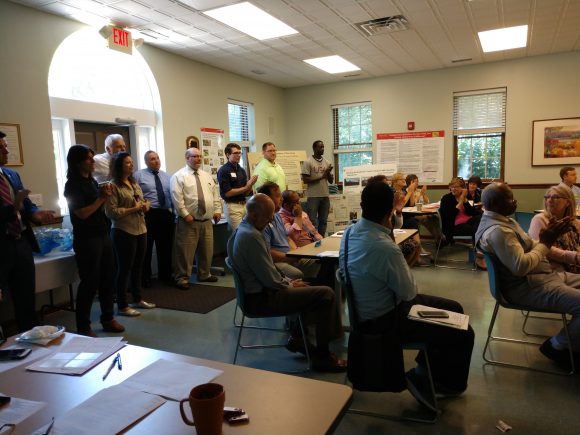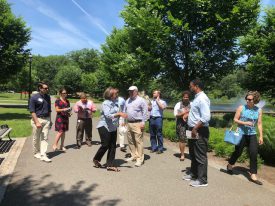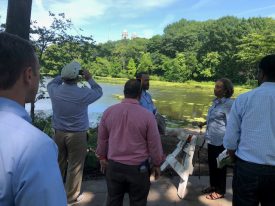
Guests at Essex County RCE listen to presentations on NJAES urban programs.
The Board of Managers (BOM), an advisory group to the Rutgers New Jersey Agricultural Experiment Station (NJAES), is made up of representatives from New Jersey’s county boards of agriculture. The Board also serves as advocate for the experiment station and provides input to NJAES’ directors on matters concerning the state’s agricultural enterprise. In addition to regular board meetings with NJAES directors, the BOM hosts an annual tour of NJAES research facilities to get an in-depth perspective of the agricultural, environmental and nutritional research and outreach conducted by Rutgers faculty, staff and students. The BOM representatives invite legislators, county freeholders and fellow county board of agriculture members to attend the tours.
Last year, in light of flat funding and increased expenditures for the experiment station, the board expanded the tours to four locations around the state to enhance the opportunity for legislators, legislative aides and freeholders to attend and realize the value of state and county funds in support of the Experiment Station. The “Discovering New Jersey’s Agricultural Experiment Station” half day tours were co-sponsored by the New Jersey Department of Agriculture/State Board of Agriculture, the New Jersey Farm Bureau, the New Jersey Agricultural Society, and the NJAES Board of Managers.
On June 12, the BOM hosted the fourth tour for legislators to enhance their awareness of NJAES outreach and impacts around the state. The three previous tours highlighted work in the agricultural, environmental, equine and turf sectors at the research and extension centers in central and southern New Jersey. Read here for an overview of the other tours.
The final tour focused on the vast urban outreach taking place in the northeastern counties. At the Essex County Rutgers Cooperative Extension (RCE) office in Roseland NJ, a group of senators, assembly persons, freeholders, legislative aides, county board of ag members, and others gathered for a briefing on the wealth of programs taking place in North Jersey. BOM president Frank Yesalavich welcomed guests. RCE director Larry Katz gave an overview of the array of programs conducted by the four extension departments: Family and Community Health Sciences (FCHS), 4-H Youth Development, Agriculture and Natural Resources (ANR), and Office of Continuing Professional Education (OCPE). Faculty and staff from the departments discussed their programs involving food waste in schools, support for out-of-school, disconnected and court involved youth, STEM programs for youth, horticultural programs for veterans and seniors, community gardening, SNAP-Ed, urban agriculture and community-based input landscape design.

RCE director Larry Katz and dean of agriculture and urban program Laura Lawson address the group.
Family and Consumer Health Sciences educator Sara Elnakib, RCE of Passaic County, talked about a project conducted in Paterson schools that tackled the costly issue of food waste. By working with food service personnel, the schools were able to significantly reduce food waste and incur substantial savings for the school district. Sara Nolan, assistant Director of Youth Development Rutgers T.E.E.M. Gateway, Rutgers Transitional Education and Employment Management (T.E.E.M.) Gateway is dedicated to helping youth and young adults on a path to success in education and employment. The support service program serves out-of-school, disconnected and court-involved youth across New Jersey, with the initial program launched in Newark.
4-H county agent Marissa Staffen, RCE of Essex County covered 4-H projects involving food and agriculture, including a joint project, Montclair Community Farms which offers youth the opportunity to grow and sell vegetables and to increase access to affordable fresh produce in local neighborhoods. Jan Zientek, agricultural program coordinator, RCE of Essex County highlighted a Rutgers Master Gardeners horticulture for seniors project. In collaboration with New Jersey Farm Bureau, a high tunnel was constructed on an abandoned housing lot in East Orange, as part of a community garden project and will be used as an outreach tool to educate and train local youth and adults in urban agriculture. The construction crew included several military veterans involved in a horticulture training program organized by RCE of Essex County. Several graduates from the program are now working in horticultural businesses.

Barbara Bell Coleman, co-chair of the Branch Brook Park Alliance led the tour through the park. Photo by Serena Claiborne
The breadth of Rutgers urban programs also encompasses an educational component for the next generation of urban planners and designers. The Department of Landscape Architecture at Rutgers School of Environmental and Biological Sciences (SEBS) offers opportunities for students to learn and work with urban communities through several programs, including its affiliation with the Office of Agriculture and Urban Programs. Dean of agriculture and urban program Laura Lawson discussed community gardening – a practice that dates back to the late 19th century in the US, as a conduit for integration in urban agriculture programs which take many forms: community gardens, urban farms, farmers’ markets, community-supported agriculture and school gardens. Through urban agriculture, people are building community while producing food and undertaking environmental stewardship. Meredith Taylor, research associate in the SEBS Office of Agriculture and Urban Programs talked about the Ag in the City initiative involving living labs in urban parks and urban high tunnel installations. Associate professor Richard Alomar presented Newark PIVOT–an open space analysis project for landscape design students. Students have conducted analyses to create green connections to Branch Brook Park in Newark, to reduce storm water runoff by reducing impervious surface, and identify lots to be converted to public green spaces, as well as looking at developing a transportation network.

The water bodies in Branch Brook Park include streams, pools, and lakes. Photo by Serena Claiborne
The second part of the legislative visit to Essex County involved a tour of Branch Brook Park. Barbara Bell Coleman, co-chair of the Branch Brook Park Alliance, a public/private partnership that provides design expertise and funding support to help Essex County restore and revitalize the park, led the tour. Coleman discussed the challenges of maintaining a high level of operational conditions at the park and year to year maintenance. The park’s 360 acres include vast lawns, playing fields, winding paths, and miles of streams, pools and lakes and has the largest collection of Japanese flowering trees in one location in the U.S. The park design was conceived by Frederick Law Olmsted Sr. and began construction in 1896. It was the first county park to be opened for public use in the United States.
Rutgers involvement in urban ag extends to the park as well. The Master Gardeners of RCE of Essex County have trained and volunteered to prune the cherry trees, and have taken over a significant portion of their upkeep, donating hundreds of hours of volunteer labor. They’ve expanded their involvement in Branch Brook Park to include general landscaping and maintenance of particular zones in the park. In the north zone, the Rutgers Master Gardeners have focused on removing invasive plant species to allow plants from the original Olmstead design to reestablish themselves. The RCE of Essex County 4-H program oversees the Children’s Garden at Branch Brook Park where youth and families learn to grow herbs, flowers, strawberries and vegetables with the opportunity to participate in healthy living and food-related workshops.
Coleman reported a sharp rise in visitation to the park as a result of improvements and ongoing commitment to maintenance.

